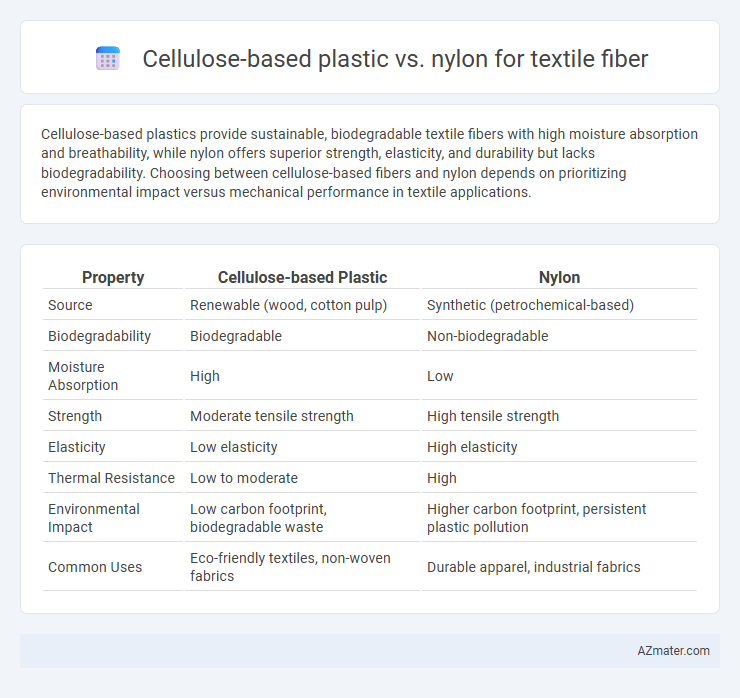Cellulose-based plastics provide sustainable, biodegradable textile fibers with high moisture absorption and breathability, while nylon offers superior strength, elasticity, and durability but lacks biodegradability. Choosing between cellulose-based fibers and nylon depends on prioritizing environmental impact versus mechanical performance in textile applications.
Table of Comparison
| Property | Cellulose-based Plastic | Nylon |
|---|---|---|
| Source | Renewable (wood, cotton pulp) | Synthetic (petrochemical-based) |
| Biodegradability | Biodegradable | Non-biodegradable |
| Moisture Absorption | High | Low |
| Strength | Moderate tensile strength | High tensile strength |
| Elasticity | Low elasticity | High elasticity |
| Thermal Resistance | Low to moderate | High |
| Environmental Impact | Low carbon footprint, biodegradable waste | Higher carbon footprint, persistent plastic pollution |
| Common Uses | Eco-friendly textiles, non-woven fabrics | Durable apparel, industrial fabrics |
Introduction to Cellulose-Based Plastics and Nylon
Cellulose-based plastics, derived from natural cellulose fibers found in plants, offer biodegradability and sustainability, making them a popular choice for eco-friendly textile fibers. Nylon, a synthetic polymer produced through petrochemical processes, provides exceptional strength, elasticity, and durability, ideal for performance-oriented fabrics in sportswear and industrial applications. The contrast between renewable cellulose sources and petroleum-based nylon highlights the ongoing shift towards greener alternatives in the textile industry.
Historical Background and Development
Cellulose-based plastics, derived from natural polymers like cellulose acetate, emerged in the early 20th century as an alternative to natural fibers, gaining prominence for their biodegradability and renewable origin. Nylon, introduced by DuPont in 1935, revolutionized the textile industry as the first fully synthetic fiber, offering superior strength, elasticity, and resistance to abrasion compared to conventional materials. The development of both cellulose-based plastics and Nylon marked significant milestones in textile innovation, reflecting shifts toward synthetic versatility and sustainability in fiber production.
Chemical Structure and Composition
Cellulose-based plastics, derived from natural polysaccharides, consist primarily of b-D-glucose units linked by b(1-4) glycosidic bonds, forming a linear, crystalline polymer with high hydroxyl group content. Nylon fibers are synthetic polyamides composed of repeating units linked by amide bonds (-CONH-) formed through condensation polymerization of diamines and dicarboxylic acids, providing strong intermolecular hydrogen bonding and elasticity. The chemical structure of cellulose imparts biodegradability and hydrophilicity, while nylon's polyamide structure contributes to superior tensile strength and resistance to abrasion in textile applications.
Production Processes Compared
Cellulose-based plastic fibers, such as lyocell or viscose, are produced through the chemical transformation of natural cellulose from wood pulp using processes like the solvent spinning method, emphasizing eco-friendly and biodegradable properties. Nylon fibers are synthesized from petrochemical-derived monomers through a polymerization process involving melt spinning, resulting in strong, durable, and elastic fibers widely used in textiles. The production of cellulose-based fibers generally requires less energy and generates fewer greenhouse gas emissions compared to the energy-intensive and chemically complex production of nylon.
Mechanical Properties and Performance
Cellulose-based plastics exhibit moderate tensile strength and high moisture absorption, making them suitable for breathable textile fibers but prone to lower durability under mechanical stress compared to nylon. Nylon fibers demonstrate superior tensile strength, elasticity, and abrasion resistance, providing enhanced durability and performance in demanding textile applications. The mechanical properties of nylon contribute to better resistance against wear and deformation, whereas cellulose-based fibers offer biodegradability and comfort but require treatment to improve mechanical resilience.
Environmental Impact and Sustainability
Cellulose-based plastics, derived from renewable plant fibers, offer significant environmental benefits over nylon by being biodegradable and reducing reliance on fossil fuels, thus minimizing carbon emissions and plastic pollution. Nylon, a synthetic polymer made from petrochemicals, requires high energy consumption during production and emits nitrous oxide, a potent greenhouse gas, contributing to environmental degradation. Emphasizing circularity, cellulose fibers support sustainable textile practices through biodegradability and compostability, whereas nylon's persistence in ecosystems presents challenges for waste management and long-term sustainability.
Biodegradability and End-of-Life Options
Cellulose-based plastics demonstrate superior biodegradability compared to nylon, breaking down naturally in composting conditions within months due to their organic polymer structure. Nylon, derived from petrochemicals, resists biodegradation and often requires energy-intensive recycling or landfill disposal, posing environmental challenges. End-of-life options for cellulose fibers include industrial composting and anaerobic digestion, while nylon primarily depends on mechanical or chemical recycling methods with limited biodegradation potential.
Applications in Textile Industry
Cellulose-based plastics are extensively used in textile fibers for their biodegradability and excellent moisture absorption, making them ideal for sustainable fashion and comfortable clothing. Nylon fibers offer superior strength, elasticity, and abrasion resistance, which supports their widespread use in activewear, hosiery, and technical textiles. The textile industry leverages cellulose-based fibers for eco-friendly fabrics, while nylon remains dominant in performance-oriented applications requiring durability and resilience.
Cost-Effectiveness and Market Trends
Cellulose-based plastics offer a renewable and biodegradable alternative to nylon, with production costs increasingly competitive due to advancements in bio-based polymer technologies. Nylon remains dominant in textile fibers due to its durability and established manufacturing infrastructure, but rising environmental concerns are shifting market trends towards sustainable cellulose-derived fibers. Market analysts predict growing demand for cellulose-based fibers driven by consumer preference for eco-friendly textiles and supportive regulatory policies encouraging bioplastics.
Future Perspectives and Innovations
Cellulose-based plastics offer sustainable alternatives to nylon in textile fibers by utilizing renewable resources and enhancing biodegradability, addressing environmental concerns linked to synthetic polymers. Innovations such as chemically modified cellulose derivatives and bio-based composites are improving mechanical strength and moisture management, narrowing the performance gap with nylon fibers. Future perspectives emphasize scalable production techniques and integrated biorefinery approaches to optimize the lifecycle impact and functional versatility of cellulose-based textile fibers.

Infographic: Cellulose-based plastic vs Nylon for Textile fiber
 azmater.com
azmater.com